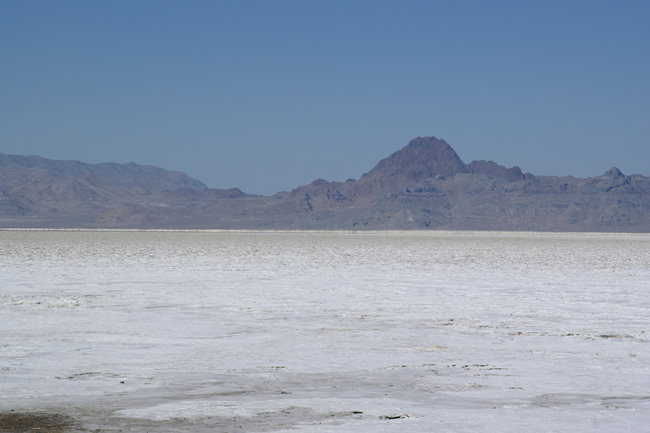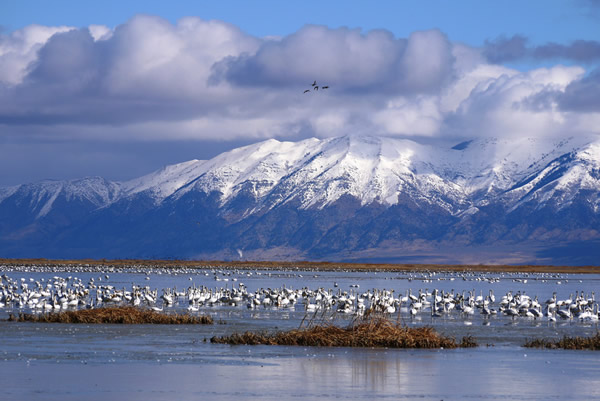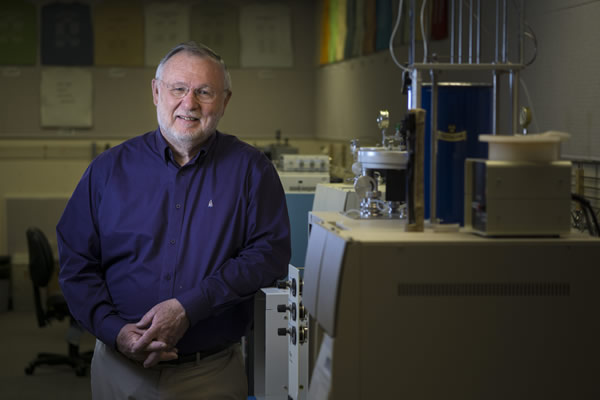Research News
September 14, 2016
Scientists Try To Solve The Puzzle Of The Shrinking Salt Flats Crust
iUTAH researcher Brenda Bowen, a University of Utah geoscientist, talked with reporter Judy Fahys on KUER radio about the research her team is doing to help solve the mystery of the shrinking crust at the Bonneville Salt Flats. The story says that research led by Bowen “is logging where the Lake Bonneville floor ends and where the layers of clay, gypsum and salt begin. Other data, like oxygen levels, is important too. The study is even looking at microbacteria. The researchers are exploring the reasons the salt crust is shrinking in breadth and depth.”
“We can look at that level of impact of what we’re doing,” says Bowen, “but we can also understand how is that relative to the scale of geologic change, of natural change, and ecological evolution even beyond what humans are doing.” Research, including data collection, on the salt flats is funded by a $1.5 million dollar grant from the National Science Foundation.

Photo credit: Hermann Luyken (Own work) [CC0], via Wikimedia Commons
September 6, 2016
A New Tool For Wetland Management
Utah State University researchers, including iUTAH researcher David Rosenberg, a professor in civil and environmental engineering, were recently featured in the news for contributions on the development of a model to improve arid-region wetlands.
The study was published in Water Resources Research on Sept. 1. Rosenberg, along with Omar Alminagorta, a former postdoctoral associate at the Utah Water Research Lab and USU Associate Professor Karin M. Kettenring, a wetland ecologist, co-authored the study. Findings show that if refuge managers implement the model's recommendations, they could nearly double the area of productive wetland habitat using existing resources." We found that more dynamically altering the water levels in wetland units at the refuge improves habitat for migratory birds," said Rosenberg.
In an excerpt from the EurekaAlert article “Rosenberg adds that adjusting water levels within wetland units more frequently also better corresponds to historical hydrologic conditions. The model also suggests focusing efforts to control invasive vegetation - particularly for phragmites, a widespread invasive grass - in late summer rather than early fall. These two changes, he explains, could significantly increase the habitat area for priority migratory bird species that use the refuge. ‘The model shows us how to better use scarce water, labor and financial resources to achieve the goals set by the refuge managers each year,’ said Rosenberg.”
Press: USU Today | EurekaAlert | ScienceDaily | Natural Science News | Utah Public Radio

Photo credit: Chris Luecke.
August 16, 2016
As a sustainability measure aimed at ensuring your data are available in the long term, all iUTAH datasets are being moved to a larger system called HydroShare for data publication. HydroShare is a new system developed by USU researchers, along with other partners. It includes the functionality of the current iUTAH Data Repository with some additional benefits:
· it supports formal publication of research products, including issuing citable digital object identifiers (DOIs)
· it supports collaborative groups with both public and private sharing of resources
· it supports sharing both data and models
Although there is some work involved in transitioning to HydroShare, the iUTAH Cyberinfrastructure Team is doing as much of this work as possible to ensure that any effort required of collaborators is minimal.
If you have submitted datasets to the iUTAH Data Repository: The iUTAH Cyberinfrastructure Team is handling the transfer of your datasets from the iUTAH Repository to the HydroShare system. In the next few weeks, we will contact you about your datasets. You can create a HydroShare account, and we will transfer ownership of the datasets to you. You can then edit and curate your datasets if needed (especially for those datasets that are currently private) and formally publish them. We will maintain pointers from the iUTAH Repository to HydroShare to redirect any potential users who have the old links.
If you have not yet submitted datasets to the iUTAH Data Repository: You can submit your datasets directly to HydroShare. We are preparing some instructions and a tutorial video for this process. You are welcome to submit datasets without that guidance or wait until the instructions are more complete.
Jeff Horsburgh, Amber Jones, and the iUTAH Cyberinfrastructure Team appreciate the work that many of you have done to add your datasets to the iUTAH Data Repository, and welcome you to contact them directly with questions about the transition.

June 1, 2016
Study: Snowpack Shifts as Wasatch Warms
University of Utah and iUTAH researcher Court Strong was recently featured in the news. A new study by Strong and his colleagues finds that the spring snowpack may be more vulnerable to a warming climate in coming decades.
A news release written by the University of Utah said “The study, accepted for publication in Geophysical Research Letters, models the year-to-year variability in precipitation and temperature in Utah’s Wasatch Mountains and other ranges in the West. Jason Scalzitti, a graduate student in atmospheric sciences, and professors Court Strong and Adam Kochanski found that above a threshold elevation, the amount of spring snowpack is dependent more on the amount of precipitation in a year than the temperature. In other words, whether a year is wet matters more than if it’s warm. But below that threshold, temperature matters more. By the end of the century, according to the study, that threshold will move uphill by around 800 feet in the Wasatch and more in the Sierra Nevada, Cascades and parts of the Rocky Mountains."
In an excerpt from the KUER Radio article, "Strong and his team at the University of Utah suggest a different question: 'How warm will it be?’ That’s because of climate change. 'In the current climate, the springtime snowpack depends mainly on the precipitation we had in a particular winter and how warm it was in that winter plays a secondary role,' he says. 'But as we go out to the end of the current century, those two drivers switch places.’"
Press: UU News | EurekaAlert | KUER Radio | Inside Climate News


May 10, 2016
Ecologist James Ehleringer Elected To National Academy Of Sciences
iUTAH researcher James Ehleringer, distinguished professor of biology at the University of Utah (UU), is among 84 U.S. scientist-scholars and 21 foreign associates from 14 countries elected at the Academy’s Annual Meeting in Washington, D.C. In a UU News statement, Ehleringer says he learned of his election when five of his colleagues, including UU geochemist and National Academy of Sciences member Thure Cerling, called Ehleringer at 7:30 a.m. Tuesday, May 3 from Washington, D.C. to share the news. Ehleringer says he is “overwhelmed, elated and excited” by the recognition. Of his colleagues within the National Academy, he says, “It’s an honor to be considered among their ranks.”
In addition to this honor, Ehleringer was also awarded the Rosenblatt Prize for Excellence, the UU’s most prestigious faculty award. An excerpt from the award announcement recognizes Ehleringer as “one of the most influential scientists in the world in plant ecology and stable isotope ecology…. He was the first to initiate a cross-campus conversation about how to embrace and incorporate Red Butte Creek into the university’s academic agenda, and he spearheaded a National Science Foundation grant to provide scholarships to first-generation students to study in STEM fields. Through it all, he has impacted the lives of numerous students, mentoring them through their time at the U and beyond.”
“I am delighted that Jim’s accomplishments have been recognized by these prestigious awards,” said Michelle Baker iUTAH EPSCoR Project Director. “iUTAH came about because of Jim’s vision and leadership in 2009 when Utah became eligible for EPSCoR. He is an invaluable member of our team.”
Ehleringer has been recognized with the state of Utah Governor’s Medal for Science and Technology, received the Student’s Choice Award for Teaching, the U’s Distinguished Research Award, the Alexander von Humboldt Fellowship, was named an American Geophysical Union Fellow, an American Association for the Advancement of Science Fellow.
Press: UU News



